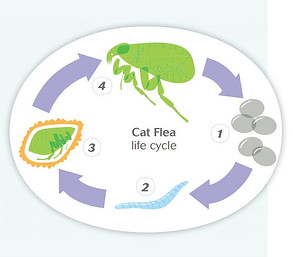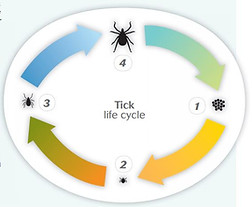Heartworm, And Fleas, And Ticks

Oh My!
-
What they are
-
What they do
-
How to prevent them
Heartworm
What Is It?
Heartworm disease is a potentially fatal disease that is caused by a parasitic worm known scientifically as Dirofilaria immitis. These worms can grow to lengths of 12 inches and gather in the heart, lungs, and blood vessels. This can lead to such problems as heart failure, lung disease, and other organ system damage.

Heartworms are a
real danger
Heartworms pose a serious threat
to dog's and cats' health and are
transmitted by mosquitoes
Heartworm disease is
hard to treat
Heartworm infestation is difficult and
expensive to treat in dogs and there
is no approved treatment for cats
Heartworms are easy
to prevent
Heartworm preventives are effective
and easy to administer to pets
Symptoms
Heartworm disease can be unapparent or severe, depending on certain factors. These include the stage of the parasite, the location, the number present, and the severity of the host reaction. The observed syndrome is more a disease of the lungs than of the heart.
Dog: Common symptoms include a mild persistent cough, reluctance to exercise, fatigue after moderate activity, decreased appetite, and weight loss. As heartworm disease progresses, pets may develop heart failure and the appearance of a swollen belly due to excess fluid in the abdomen. Dogs with large numbers of heartworms can develop a sudden blockages of blood flow within the heart leading to a life-threatening form of cardiovascular collapse. This is called caval syndrome, and is marked by a sudden onset of labored breathing, pale gums, and dark bloody or coffee-colored urine. Without prompt surgical removal of the heartworm blockage, few dogs survive.
Cats: Signs of heartworm disease in cats can be very subtle or very dramatic. Symptoms may include coughing, asthma-like attacks, periodic vomiting, lack of appetite, or weight loss. Occasionally an affected cat may have difficulty walking, experience fainting or seizures, or suffer from fluid accumulation in the abdomen. Unfortunately, the first sign in some cases is sudden collapse of the cat, or sudden death.
Life Cycle
Mosquitoes take up infected blood where the microfilariae travel to the excretory system. After developing further in the mosquito the larva travel back to the mouth parts where they will be transferred to a suitable host once the mosquito feeds. The larva moves into the bite wound where they migrate towards their preferred locations, either the right ventricle of the heart or the main pulmonary arteries. Some larva are also able to penetrate tissues in the body and can end up in muscles of the abdomen and thorax. They molt into an immature adult typically around 50-70 days of life. Adult heartworm can reach sexual maturity at 6-6.5 months, at which point the females may be up to 12 inches long and the males 15-19 centimeters. Some reports indicate that female worms can live and continue to produce for up to 7 years. Their survival is typically quoted around 5-7 years.
Veterinarians should expect higher-than-average caseloads of Lyme disease and heartworm infection according to the Companion Animal Parasite Council

While heartworm case
distribution hasn't
changed much
since 2013,
the average number of
cases per clinic
has risen nearly
22 percent
Prevention
There are many safe, effective heartworm preventives out there. Whether the preventive you choose is given as a pill, a spot-on topical medication or as an injection, all approved heartworm medications work by eliminating the immature (larval) stages of the heartworm parasite. This includes the infective heartworm larvae deposited by the mosquito as well as the following larval stage that develops inside the animal. Unfortunately, in as little as 51 days, immature heartworm larvae can molt into an adult stage, which cannot be effectively eliminated by preventives. Because heartworms must be eliminated before they reach this adult stage, it is extremely important that heartworm preventives be administered strictly on schedule (monthly for oral and topical products and every 6 months for the injectable). Administering prevention late can allow immature larvae to molt into the adult stage, which is poorly prevented.
At our clinic we offer TriHeart and Interceptor. Both of these also have some protection for intestinal parasites. However, a prescription is needed to buy these. By keeping exams and heartowrm tests (4dx tests) up to date your animal can have the best chance at protection.

Fleas
Infestation
If an infestation of fleas occurs it can easily take at least three months, if not longer, to treat.
Not only does the pet need to be properly treated, but the local environment, your home, needs to be treated as well. The yard may need to be treated as well, as this is generally where the fleas originated. This means lots of cleaning and washing. Vacuuming is important, not only the areas you can see but also under furniture, in the cracks of the floorboards, and in-between the couch cushions. Vacuuming will not kill fleas or eggs, they are resilient and will crawl right back out into the environment. They love dark, warm, moist environments. Flea eggs can and will fall off of their host, hatch, and can remain in the pupa stage for up to eight months or until the environment cues trigger them to a nearby host. They will then mature into adults and the infestation will continue.
Life Cycle

Infestation = $$$$
Although the cost of some
preventive products can seem
like a lot, in the end
it will be much cheaper than
treating an infestation

-
Egg: eggs are deposited on the pet and fall into the environment within a few hours.
-
Larva: larvae are maggot-like and approximately 0.5cm long. They feed on blood in adult flea feces, organic debris, flea egg-shells and other flea larvae.
-
Pupa: whitish cocoons c an be found in soil, on vegetation, in carpets, under furniture and on animal bedding.
-
Adult: adults begin feeding immediately when on a pet-usually within three minutes.
-
Eggs production begins within 20-24 hours of females taking their first blood meal.
-
Females can produce 40-50 eggs per day-that's nearly 3,000 fleas in two months!
-
During the warm summer months, the entire flea life cycle can be completed in two to three weeks.
-
Ticks
What To Know
Ticks crawl up: ticks live on the ground no matter the locale, this means wooded or otherwise. They typically crawl up from glass blades onto a host and migrate upward. They want to feed around the head, neck, and ears of their house, where the skin is thinner. They also like protected, creased areas such as armpits.
Cold and snowy is no problem: Winter doesn't bother certain tick species. In fact, adult stage deer ticks become active every year after the first frost. While some ticks go dormant, deer ticks will be active any winter day that the ground is not snow-covered or frozen.
Ticks carry disease: The trend is increasing abundance and geographic spread of deer ticks and lone star ticks; and scientists are finding an ever-increasing list of disease-causing microbes transmitted by these ticks. Ticks are second to only mosquitoes in the number of diseases they transmit.
Removal: The best way to remove a tick is grasp it as close to the skin as possible with tweezers and pull the tick's body out with a steady motion. Experts often discourage killing the tick before removal.
Preventable: There's only one way to become infected with a tick-transmitted disease, and that's from a tick bite. Remember, just one bite is all it takes to make you or your pet sick-so prevention is your best bet.
Help prevent transmission of tick-borne disease by inspecting your pets every time they go outside
Life Cycle
-
Egg: An engorged female tick can lay up to several thousand eggs in sheltered environments (not on a host)
-
Larva: the six-legged larval stage hatches from the egg within weeks to months, depending on environmental conditions. Larvae remain on the ground or on low vegetation waiting for a host, which is usually a bird or small mammals.
-
Nymph: After feeding on a host for several days, the engorged larva drops to the ground and molts into an eight-legged nymp,. The nymph then finds an appropriate host and feeds for several days to a week.
-
Adult: Once the nymph has engorged, it drops to the ground and molts to the eight-legged adult, which then must find a third host-you or your pet, maybe?



Prevention
Ticks' saliva has anesthetic properties,
meaning their bites are painless. Hosts generally don't feel them bite. What's worse: less than half of people who've
been infected with Lyme disease
show the "bull's-eye rash"
Most people are led to believe that flea and tick products are deterrents, keeping the parasites off their pets completely. In reality, this is not the case. Preventives are the prevention of an infestation of the potential spread of disease. These products combined with early detection are key when it comes to safeguarding pets against tick-borne disease. You can help by inspecting your pets every time they go outside. Also, using a flea and tick preventive, or combination of them, can increase the odds of preventing a disease from taking hold.
We offer a variety of products here including over-the-counter topical Vectra 3D as well as some natural options. As always, Bug Off! Garlic is a favorite of the Doctor, and we are also offering Dr. Mercola herbal flea and tick collar. These collars are a blend of different essential oils that are safe for your pets but help to deter flea and ticks from latching on.

References/Further Reading
-
http://veterinaryteam.dvm360.com/power-your-veterinary-clients-efforts-flea-prevention
-
http://veterinaryteam.dvm360.com/boost-veterinary-clients-tick-iq
-
http://veterinarynews.dvm360.com/important-heartworm-basics-practicing-veterinarian
-
https://www.heartwormsociety.org/pet-owner-resources/heartworm-basics

